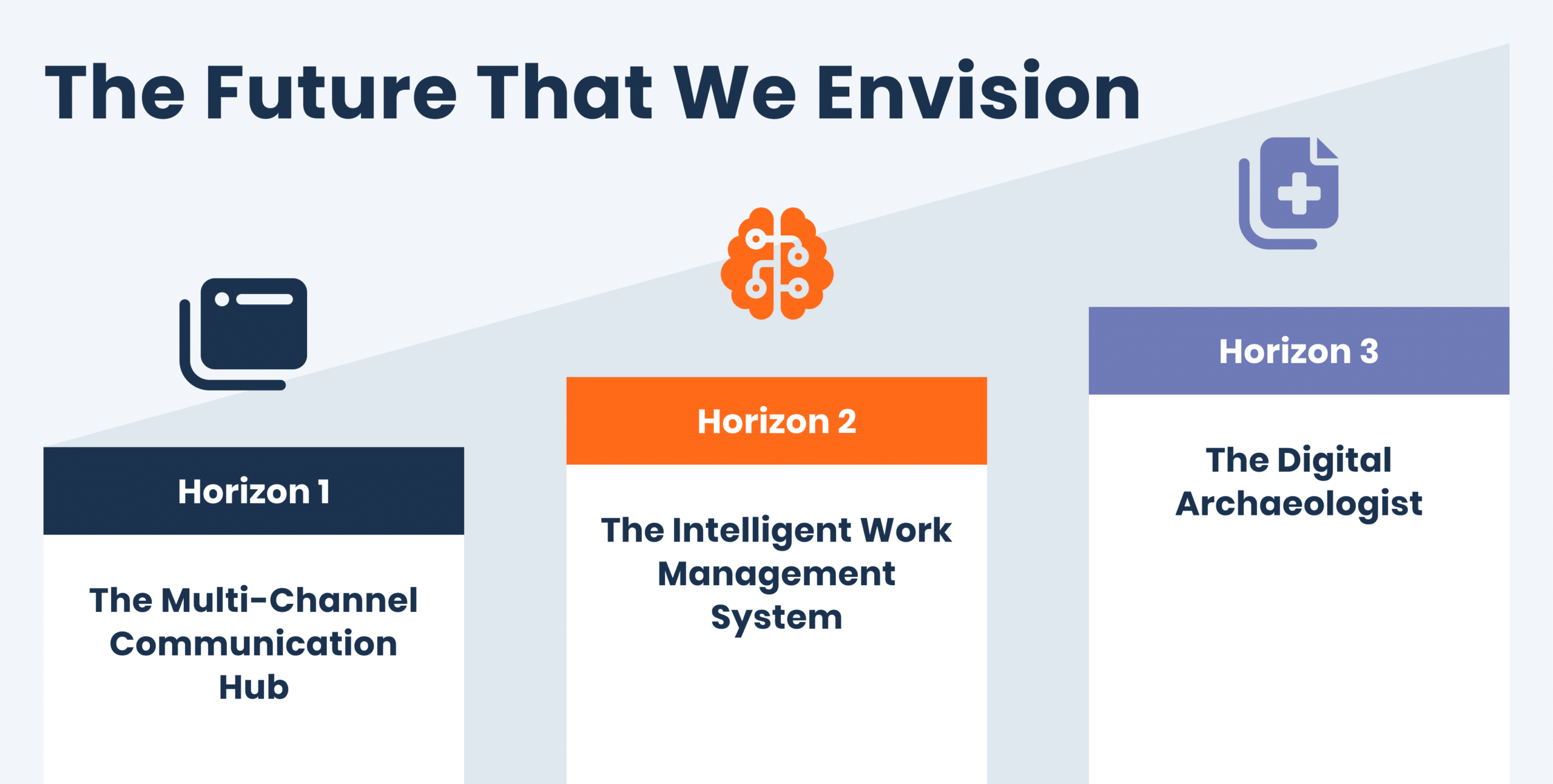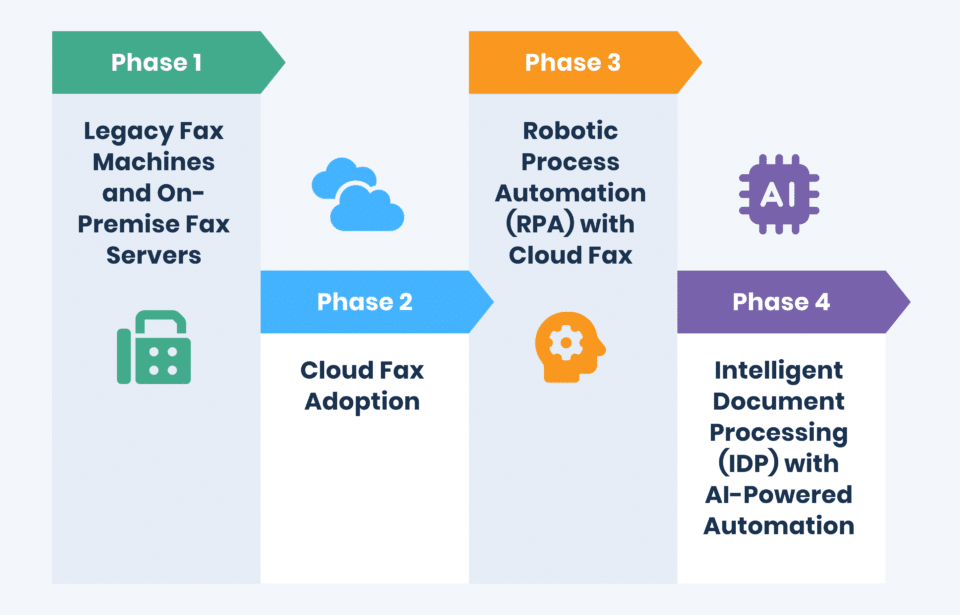A few weeks ago, Documo CEO Denis Whelan published a great article outlining a 4-phase maturity model leading from legacy fax machines to AI-powered Intelligent Document Processing. He explained how healthcare providers could embark upon an evolutionary journey, each subsequent step building upon the prior one, from their outdated communication infrastructure to one that is more secure, compliant, and scalable.
We thought it would be useful to follow up on that article and talk more aspirationally about our vision of the future. A vision of what would be useful to help medical care providers tame the inherent complexity in our healthcare system. A vision beyond the immediate future and examined in phases over three horizons.
We see enormous opportunity to transform operationally how healthcare is delivered. By helping to relieve some of the crushing administrative burden, we want to subtly but surely shift the investment made in healthcare from communication and coordination to actually delivering quality care. We are committed to reducing the overwhelming administrative burden in healthcare. To achieve this, we must move beyond discussions and invest in solutions that directly improve patient outcomes.
Table Of Contents:
Horizon 3: The Digital Archaeologist
Trend 1: Increased Specialization
Horizon 1: The Multi-Channel Communication Hub
Horizon 2: The Intelligent Work Management System
The Challenge
Several hundred years ago, healthcare was a simple affair. If you were in need of medical attention, you might be able to be seen by a midwife or a barber surgeon or a folk healer. The average person might be lucky enough to see a medical “professional” a couple of times in their life and they’d receive attention that was often a curious mix of tradition, superstition, and pseudo-science. The effectiveness of that healthcare was such that a baby born in that time might only have a 50/50 chance of celebrating their first birthday and might only expect to live into their 20s or 30s.
Fast forward to today, and advances in hygiene, prenatal care, and access to vaccines has reduced the infant mortality rate to under one in 100 in developed nations, and median life expectancy is just shy of 80 years. However, those advances in healthcare outcomes have come at a price–a price that can be summed up in three of the major healthcare trends affecting us today: increased specialization, rising costs, and the patient/payor divide.
Trend 1: Increased Specialization
The sheer quantity of medical knowledge in the world today is so vast that the practice of medicine is segmented into dozens of horizontal specialties from anaesthesiology to vascular surgery. In an attempt to control costs, vertical specialization provides for a division of labor where the most highly skilled professionals are supported by staffs of less extensively trained but still critical providers who in turn are supported by even larger administrative teams.
It is estimated that the average person living in an industrialized nation today might interact with dozens of doctors in their lifetime along with hundreds to thousands of other healthcare professionals and medical administrators. Think about just the last visit you made to your doctor and the lab technician who drew your blood, the nurse who took your vitals, the nurse practitioner who assisted with a procedure, and the administrative staff who scheduled your referral to a specialist.
Trend 2: Rising Costs
A couple of hundred of years ago, healthcare costs represented around 2% of the Gross Domestic Product (GDP) of the US. According to the Centers for Medicare & Medicaid Services, that number has expanded to 17.6% today. This $5 trillion annual expenditure at first feels like an abstract statistic. But, an amount of $14,500 per man, woman, and child alive in the US underscores the sheer magnitude of the cost of accessing healthcare in modern society.
Of course, this cost isn’t evenly spread across cohorts in the population, nor is it spread evenly across time for an individual person. About 5% of the population accounts for nearly half the healthcare spending in the US, driven by factors such as an aging demographic and a high prevalence of patients living with chronic conditions. From a timing perspective, many patients may go years needing little more than an annual check-up, but suddenly find themselves facing large medical bills from an unwelcome diagnosis, an accident, or the onset of a chronic condition.
Trend 3: Patient/Payor Divide
This unpredictability of healthcare needs represents a significant financial risk to patients that is often offset by health insurance. Whether purchased on the private market or through public, government-sponsored programs, medical insurance helps to reduce that financial exposure by pooling risk and sharing costs amongst a larger group of people.
The notion of health insurance introduces an additional actor to the patient/provider relationship, the payor. Separating the patient from the payor is a key step that necessitates a whole set of checks and balances to ensure necessary procedures are necessary and, once completed, appropriately paid for.
Administrative Complexity
The common element to these three particular healthcare trends–increased specialization that has contributed to rising costs that has necessitated separating patients from payors–is that they vastly increase the number of people and organizations that need to be kept in the loop about an individual patient’s healthcare. Whether it’s accessing a person’s medical history, coordinating care amongst multiple specialists, or ensuring accurate billing and payment for services, communication and coordination in the healthcare system has become exponentially more complex.
The National Institutes of Health estimates this administrative complexity costs on the order of $265 billion per year. Every dollar spent on this crushing administrative burden is a dollar that could be saved or spent on more directly improving patient outcomes.
The Promise of Technology
Technology isn’t everything, but it can play a key part in streamlining the information flows that represent a large portion of that $265 billion in administrative complexity. Researchers estimate that the amount of medical knowledge in the world doubles every 73 days, a pace with which humans cannot be expected to keep up. More is not always better. With the right technology assistance, healthcare professionals can access and securely share the right information to the right people at the right time and make sense of the vast amounts of data at their disposal.
Researchers estimate that the amount of medical knowledge in the world doubles every 73 days.
In Denis’ recent blog post, Transforming Healthcare Cloud Fax Interoperability: The 4 Phases of Maturity, he lays out a vision that bridges the gap between the legacy fax machines that are ubiquitous around the healthcare landscape today with the AI-powered Intelligent Document Processing (IDP) future that we see just over the horizon. Here’s a glimpse into what we see over the next few horizons after that:
- Horizon 1: The Multi-Channel Communication Hub
We envision a one-stop communication hub that would enable frictionless communication regardless of format, transmission channel, or terminology. By removing the need for a medical professional to have to think about what communication channel is preferred by what provider, or how to translate information from one format to another depending on that channel, they can spend their time thinking more about what matters most: patient care. - Horizon 2: The Intelligent Work Management System
Too often, the healthcare system forces the burden of coordinating care and ensuring follow-up on the patient or caregiver. Too often, this burden is placed on them at a time when they are the most vulnerable and least equipped to handle it–during periods of illness or recovery. We foresee an intelligent work management system that can orchestrate actions across multiple sources of truth and multiple communication channels to shift the burden of this coordination and follow-up from the patient back to the healthcare provider. - Horizon 3: The Digital Archaeologist
Modern healthcare systems generate vast amounts of individual pieces of data ranging from test results and imaging studies to clinicians’ notes and referrals. A study by the World Economic Forum estimates that a typical hospital system produces 50 petabytes of data per year, of which only about 3% is productively used. While this information in isolation is undoubtedly valuable, it’s often difficult to see the forest for the trees and understand the complete picture of a patient’s health journey. We envision a system that could play the role of a digital archaeologist, sifting through digital artifacts produced by the myriad of healthcare systems and organizing them into a comprehensive story capable of being quickly understood by overworked and overwhelmed healthcare professionals.
The journey from the simple but less effective healthcare of centuries past to the sophisticated but complex environment of today has been one characterized by remarkable progress as well as unforeseen challenges. The pressures of increased specialization, rising costs, and the patient/payor divide have led to a landscape where the crushing administrative burden of communication and coordination must not be allowed to overshadow the core mission of patient care.
Counterbalancing these challenges lies the promise of technology, and in particular, the thoughtful and responsible application of technology. We envision a transformation of the way in which healthcare operates by applying technology over three horizons: via multi-channel communication hubs, intelligent work management systems, and technology-enabled assistants that can play the role of the digital archaeologist.
We’ve intentionally slotted in AI-based approaches only where we believe them to be appropriate to avoid the temptations of catering to the hype of the moment or implementing technology in search of a purpose. Rather, we’ve envisioned technology specifically designed to assist and empower healthcare professionals to allow them to focus less on administrative mechanics and more on what truly matters: delivering exceptional patient care.
Much of this raw vision is possible with technology available today. But, that doesn’t mean there isn’t a lot of hard work ahead of us to bring practical and affordable systems to mass market adoption. If you’re interested in what Documo has available for use today as well as what we have up our sleeves for the immediate future, we’d love to hear from you. If you’re interested in giving us your perspective on what the market needs and potentially helping us refine our vision for the future, we’d love to hear from you. If you’re interested in partnering with us to help realize this vision of reducing the administrative burden in healthcare, we’d love to hear from you.
We’re passionate about bringing this vision to life, and we’d love to share some of that passion with you.


